Lesson 9 - Analysis for Policy Development
9.0 Overview
Overview
We now continue our development of broader impacts in systems design and management. So far, we have addressed the Goal of Solar Energy Design through engineering applications (Lessons 2, 3, 4) and through financial/economic applications (Lessons 5, 6, 7). In Lessons 8, 9, and 10 we are addressing the Goal of Solar Design by helping the client to manage risk in the given locale.
The Goal of Solar Design is to:
- Maximize the solar utility
- for the client
- in a given locale.
In Lesson 8, we discovered that there are meteorological phenomena that are really out of our control, and our job as a design and management team is to help the client to manage risk. Now, we continue with important design elements tied to managing risk, but within the social realm of community, regional, and federal stakeholders. In Lesson 9, we want to address helping our client to manage risk in the social environment, through our developed awareness of permitting and policy within the given locale. As we shall see, just because you have a good solar resource and a sound financial return (in principle), doesn't mean that the policies of the locale will allow one to actually implement a SECS, or to implement a system in a financially responsible manner.
9.1 Learning Outcomes
By the end of this lesson, you should be able to:
- describe the connections between policy making and renewable energy adoption at the local, regional, and federal levels;
- define the difference between solar rights and solar access;
- describe the role of net metering and permitting in solar project development;
- describe the leading methods for community solar development.
What is due for Lesson 9?
This lesson will take us one week to complete. Please refer to the Course Calendar in Canvas for specific time frames and due dates. Directions for the assignments below can be found in this lesson.
| Required Reading: |
J.R. Brownson, Solar Energy Conversion Systems (SECS), Chapter 11 - The Sun as Commons (Intro through "Framework: Emerging Local Policy Strategies") S. Bronin (2009). "Solar Rights [1]," Boston University Law Review. |
|---|---|
| Optional Reading: | R. Knowles (2003). "The Solar Envelope: Its Meaning for Energy and Buildings [8]," Energy and Builduings, 35, 15-25. |
| HOMEWORK: | Learning Activity: Community Solar Garden |
| YELLOWDIG: |
Discussion Topic 1: National PV Targets Discussion Topic 2: Net Metering and Feed-In Tariffs Discussion Topic 3: Solar Rigghts and Access |
Questions?
If you have any questions, please post them to the Lesson 9 General Questions thread in Yellowdig. I will check the forum regularly to respond. While you are in a discussion, feel free to post your own responses if you, too, are able to help out a classmate.
9.2 Solar Rights and Solar Access
Reading Assignment
- S. Bronin (2009). "Solar Rights [1]." Boston University Law Review. (only portions of the full paper are required reading)
- Introduction (all)
- Why Individual Solar Rights (all)
- Governmental Allocations (read the Intro; scan the sections on Permits and Zoning)
- Court Assignments of Rights (read the Intro)
- Conclusion (all)
- DSIRE Solar Portal [2]: Search by state, focusing on "Solar Access Laws". e.g., this Maryland Solar Easements and Rights Law [9].
- Wikipedia: "Solar Access [3]"
Context
One of the main limitations to deploying solar energy is just the simple ability to access the unobstructed sunlight. Here, we focus on the legal rights to access and use the Sun's energy and the functional ability to utilize solar radiation within the solar envelope. Remember that many objects and technologies that are outside can serve as solar energy conversion systems: homes and solar panels - yes! but also clothes, patios, cars, trees.
The DSIRE solar portal referenced above describes both solar rights and solar access ("easements") and provides maps [10] of US states having each or both. (I justed noted that Pennsylvania, where I live, still has neither solar access laws, nor solar rights laws).
Just think:
- In Germany, you have the right to be exposed to sunlight directly in any office scenario (no windowless cubicles permitted).
- In many states, you have the right to hang-dry your clothes on a line outside.
- In ancient Rome, an individual had the right to access solar gains or be compensated for an obstruction of that resource.
When we talk about policies for solar energy, one of the first is the basic ability to access that sunlight and then make use of it to do work!
The concept of solar rights is still emerging in the USA. I am going to recommend that you take about 10 minutes to review the current state of solar rights from the Solar America Board for Codes and Standards (the Solar ABCs [11]; choose 1 page summary). The coverage is brief but useful when considering the scope of solar legal status in the USA.
Solar Rights

The phrase "solar rights" is often used in a general sense and a specific sense. In general, solar rights are the broad class of legal rights to access and make use of the light from the Sun. In the specific sense, solar rights are distinguished from "solar access" by the following description:
- Solar Rights: the legal ability to install SECS on your property that is subject to land use restrictions. One of the classic SECS rights is the ability to dry your clothing outside on a clothes line. Perfect high utility SECS, but often blocked by local suburban covenants that would consider such displays as unwanted for the overall "appearance" of the neighborhood.
Here, solar rights describe the ability to make use of solar energy in your locale.
Solar Access
Solar access is the functional ability of a SECS within a locale to receive or "access" solar gains across property lines without shadowing or other obstruction occurring from buildings/trees/landmarks set in a nearby property. It also has to do with the enacted local policies to manage the commons of the solar resource system, and an individual's ability to be granted compensation if access is blocked in some way. Bronin (2009) has described solar access as being managed in three manners: as a solar easement, through covenants, and through lease agreements.
- Solar Easements: the legal ability for a property owner to use sunlight across property boundaries. Easements allow a designated landowner to hold some rights with respect to the property of another landowner. Such an easement will have been voluntarily bargained for and agreed upon. In such a case, one client will receive access to a solar corridor/envelope, while another landowner will receive some compensation to offset the burden from losing the access. [Bronin, 2009]
- Covenants: binding terms for current owners and those that follow later. A covenant can function well for newer subdivisions of homes, but they are more challenging to create for nonresidential regions or well-established residential areas. Of course, covenants have also been used to inhibit the use of SECS like clothes lines, foliage/tree types and density, and even visible displays of PV/SHW systems.
- Lessor-lessee arrangements: agreement that ties a solar right to the temporary term of tenancy. Solar leases will typically involve airspace (solar envelope or solar skyspace). Airspace has a common law role as real property, and is distinct from ground/mineral estates. A client owning property has the potential to sever the parcel of ground from the airspace, and then lease just the airspace. As such this type of lease allows the solar client to make use of or “occupy” the airspace without obstruction.
We have already discussed the importance of minimizing shading in SECS's that intentionally collect and convert solar gains (rather than shading devices that attempt to control solar gains). Solar access has to do with access to the solar resource within the locale over many hours of the day, and across the months of the year. Recall that we already developed some skill to assess the solar access at a site through the sun path diagrams in Lesson 2. [Hey, we just tied together something that was a lot of work earlier with an advanced topic in Lesson 9! Great!]
Solar Envelope
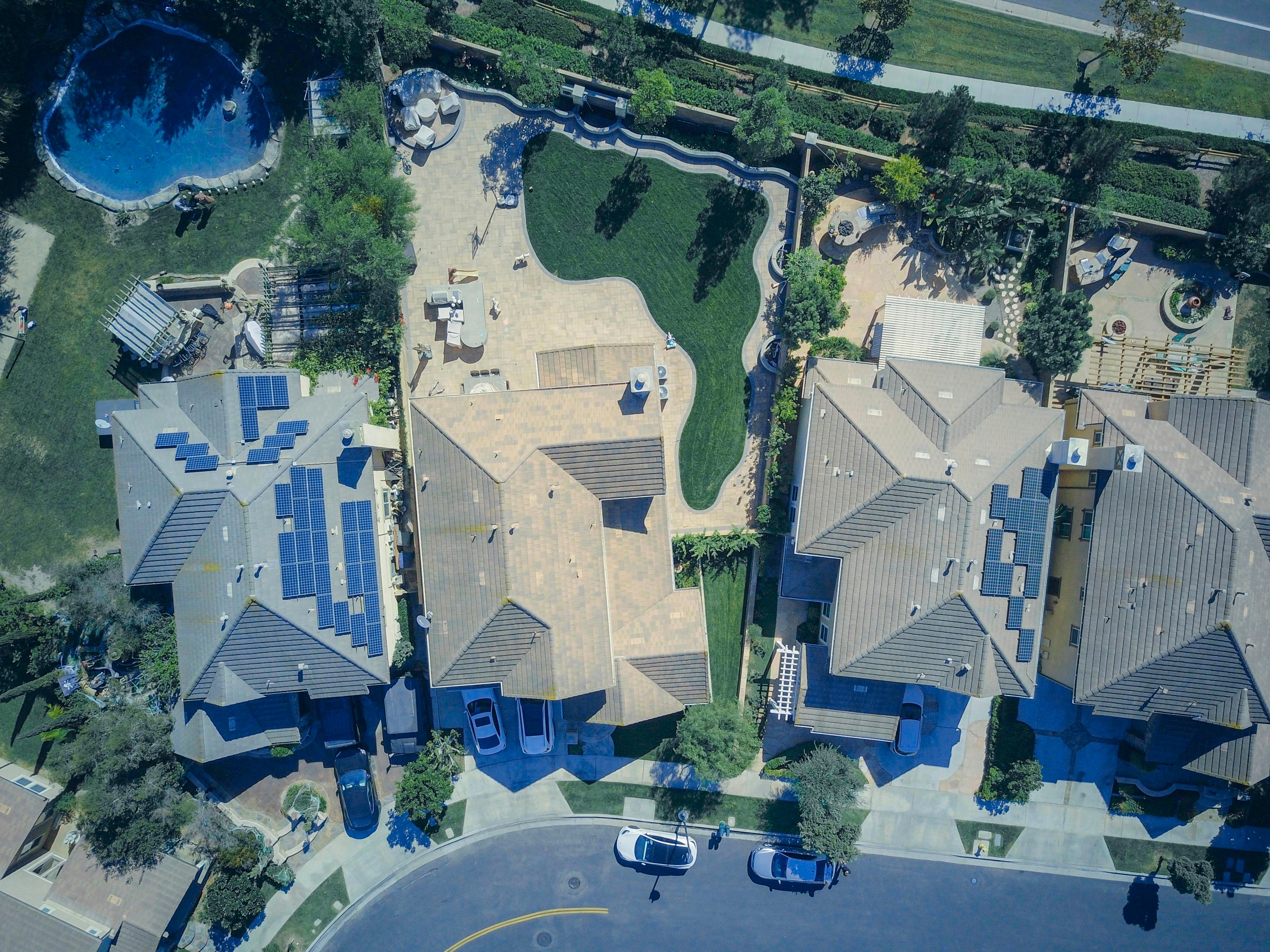
The solar envelope is an extension of solar access, conceived for urban scenarios with a cluster of buildings and obstructions. Professor Emeritus Ralph Knowles of the Dept. of Architecture, the University of Southern California, conceived and developed an extensive exploration of the solar envelope as a concept for policy development and planning.
The solar envelope as a concept was first proposed by the author as a zoning tool to provide solar access to buildings within limits set by the relative sun-earth position and motion. “Building within its boundaries will not shadow surrounding properties during critical energy-receiving periods of the day and year. Guaranteed solar access, thus, offers to society a chance to develop a renewable energy source; to architects it extends aesthetic possibilities based on the dynamics of sunlight.”
You are welcome to read about Dr. Knowles' findings in the article below as a complement to our assigned reading on the topic.
Supplemental Reading
R. Knowles, "The Solar Envelope: Its Meaning for Energy and Buildings [8]," Energy and Buildings, 35, 15-25 (2003).
Self-Check
9.3 USA: Interstate Renewable Energy Policy and Permitting
Net Metering
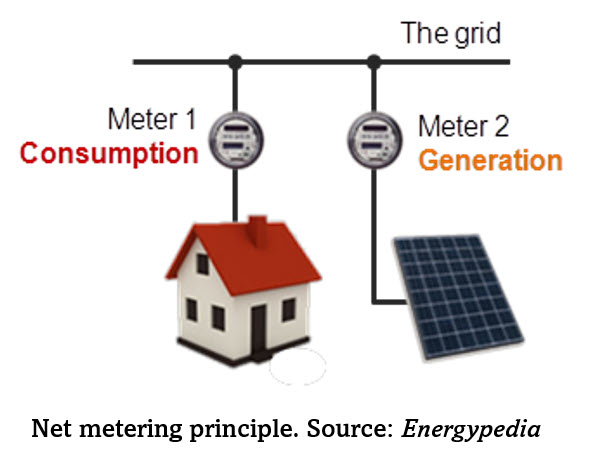
One of the adopted trends from the past decade of photovoltaic adoption is the ability to connect your solar system directly into the power grid. Policies have been adopted to allow renewable generators (both commercial and residential) to "bank" excess power into the grid and receive credits for it from the utility. In this case, if you generate as much energy on site as you consume from the grid, your net energy balance is zero, and so is your energy bill! This is of course the case if the utility company reimburses you for each kWh at the same rate as you pay for the kWh drawn from the grid. This is called Net Metering.
But each locale will be subject to different policies enabling or prohibiting such practices. Net metering is expanding in creative ways, including aggregation of multiple distributed energy sources for credit, and distributing joint credit from a centralized solar garden [12] among multiple participants in a community.
Here are some typical Q&A’s:
- What if you produce more energy on site than you consume – will you be compensated for those extra kWh supplied to the grid (and make money)?
Typically, the excess would be rolled over to the next billing cycle (month), but at the end of the year, based on the local policy, you may be compensated for extra power produced.
Example: In Florida, extra power credits roll over to the next month (no monthly cash earned). If not used by the end of the year, they are paid off by the utility, but at the wholesale rate (which is lower than retail).
- How is the power balance technically monitored?
The net metering practice would use a bi-directional meter [13] that tracks the energy flowing from the grid to your house and the energy flowing from your solar system to the grid. The kWh difference over a billing cycle is what you are charged for on your energy bill.
- Is there a cap on how much energy can be fed into the grid?
Some utilities may introduce caps to avoid overcharging the grid and also to discourage intentional oversizing of solar systems. Some utilities also set limits for the system capacity that can participate in net metering (for example, in Pennsylvania it is 50 kW for residential systems and 3 MW for non-residential systems).
- Do customers need insurance for their systems connected to the utility grid?
Policies in some states require larger solar systems to purchase liability insurance, which makes their installation more expensive, but necessarily unprofitable. In some cases, insurance is strongly recommended but not required by policy.
- Do all utilities have to provide net-metering?
State policies would spell that out. In many states, only investor-owned utilities (IOU) are required to provide net-metering. Some rural or municipal energy generating cooperatives may offer their own compensation programs but are not required to net-meter.
From the customer’s perspective, it is quite clear that net-metering provides very sensible incentives to system owners in terms of electricity bill savings. But being on the utility side of the net-metering equation is a bit tricker. There are sensible benefits too, but there are also risks. This topic has been a subject for ongoing debate on whether electric utilities win or lose here, and all kinds of pressures were put on policy makers, and policies do seem to differ quite drastically across the states.
Let’s review some of those cons and pros.
Risks to utility
While net metering offers benefits for renewable energy adoption and customer savings, there are several perceived risks for utilities related to revenue, cost recovery, and grid management.
- Revenue. Imagine that there are customers in the utility network that are at “net zero”, so they consume as much as they produce and hence do not pay anything, but the company still has to manage their accounts, provide technical support, billing, and service them. This is how they may be seen as a ‘burden’.
- Fixed costs. Utilities have significant fixed costs related to maintaining and upgrading the electricity grid, including infrastructure, transmission, and distribution. Net metering can reduce the total amount of revenue utilities receive from customers while these fixed costs remain unchanged.
This may have a few negative impacts:
- Utilities become more hesitant to invest in grid infrastructure and maintenance, which may decrease the grid reliability.
- Utilities may choose to increase electricity prices to recover some of those costs, which will also impact customers without solar systems (“cost shifting”).
- Grid stability. High levels of distributed generation can create technical challenges for managing and stabilizing the grid. Due to intermittency of solar generators, and sheer number of power contributors, grid may experience voltage fluctuations and other sorts of instability.
Despite the perceived risks, many utility companies readily pursue net metering and create programs and options for customers. So, there must be some clear benefits as well..
Utility benefits
- Avoided costs and cost savings. By generating power locally, net metering systems can eliminate the need for new, costly infrastructure investments, such as new power plants (once old ones are decommissioned) or transmission lines. As a result, the overall capital expenditures required to meet electricity demand are reduced.
- Reduced transmission losses. Local solar systems, when strategically placed, may help reduce power transmission and associated energy losses. Residential systems are already on the grid and would not require line construction like bigger solar installations sometimes do.
- Grid Resilience. Distributed energy generation can potentially improve grid resilience by providing local power during outages or emergencies. This may reduce the need for backup power generation or additional emergency infrastructure investments.
Probing Question:
From your perspective, do the benefits of net metering outweigh the risks for the utility?
How the policies developed over the last decade
Net metering policies can evolve and change over time, so once profitable, having a solar system on your roof may become less attractive if the local policy landscape becomes unfavorable, or vice versa. Having full information and unbiased assessment of policy and financial model would certainly provide a good foundation for resolving this question.
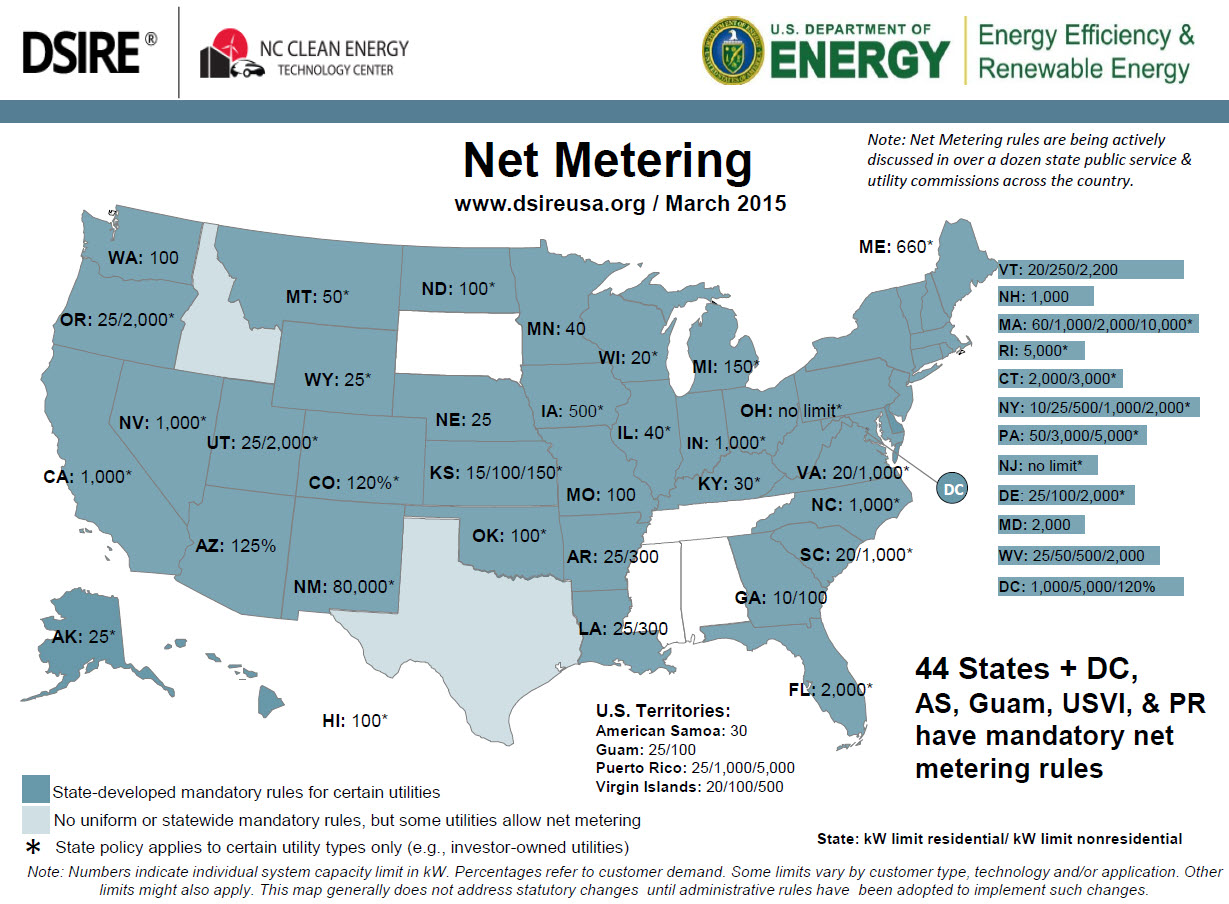
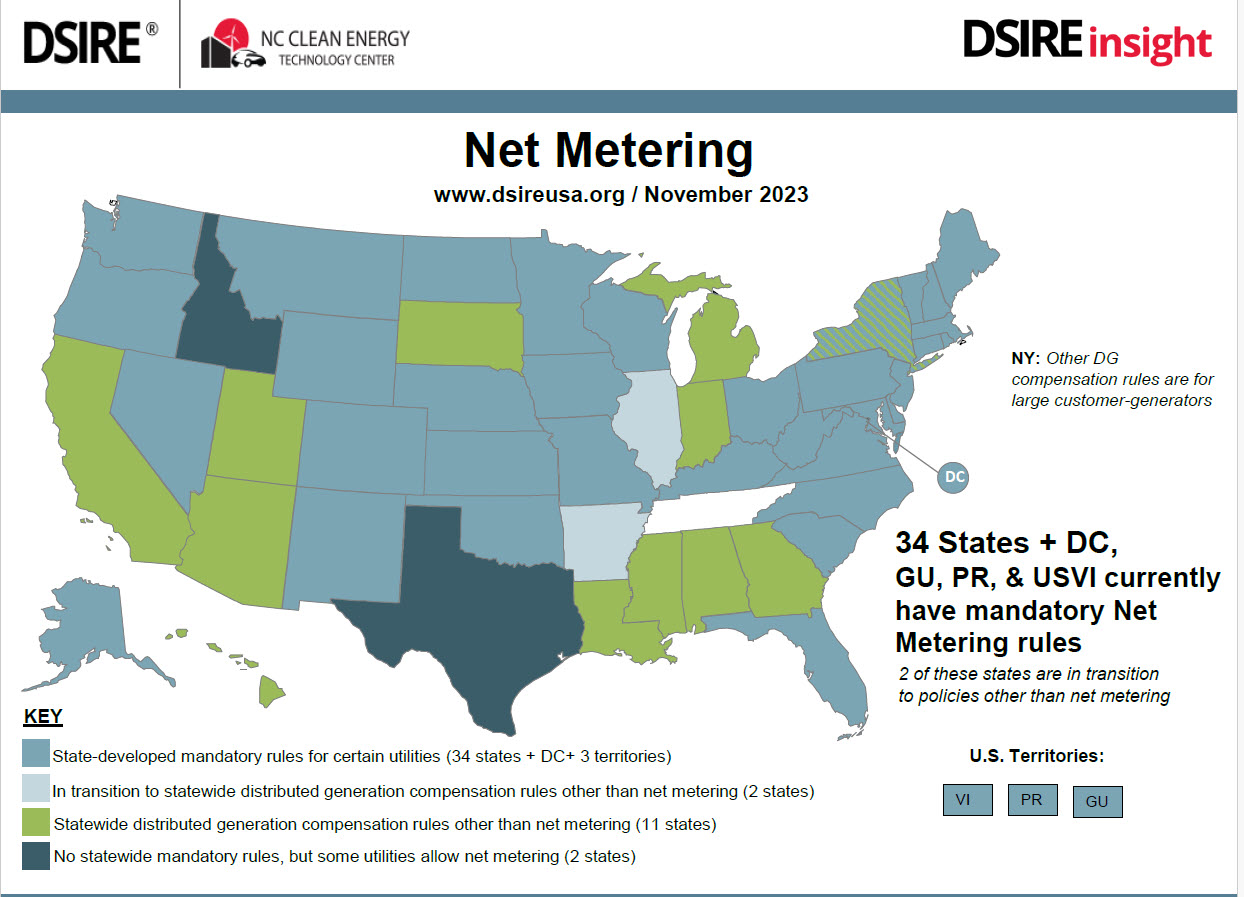
What we see from these two maps (published 8 years apart) , the number of states requiring net-metering evidently decreased by ten, while several states devised different compensation mechanisms for solar owners. What are they switching to?
Net billing
Net billing is the solar generation compensation policy some of the states are transitioning to from net metering. This shift is presumably caused by some of those utility’s concerns mentioned above.
So how’s net billing different from net metering? Primarily it is the rate you are compensated at for your solar generation.
With conventional net metering, you get the same rate for importing or exporting electricity (retail). With net billing, you import at the retail rate, but you export at the wholesale rate. So, in this case the utility values the power from the rooftop owners the same as the power from the large-scale power plants.
Net billing is a monetary exchange, and SECS owners would receive two billing statements – one for the power they ‘buy’ from the grid, and the other – for the power they ‘sell’ to the grid. Ideally, if you produce a lot more than you consume, chances are that you make some cash on the monthly basis, although for that you would probably have to oversize your solar system to really break even.
In net metering, we count kWh - in net billing, we count $.
What causes the problem is that the kWh produced and kWh consumed are no longer considered the same. Since the solar credits are compensated at a lower rate, net billing makes the solar systems less valuable and increase the payback period. Hence, there is a fear that a shift to net billing may cause significant reduction of rooftop solar business at the local level and statewide.
Examples:
- In Idaho, the net billing set the compensation rate at 5.96 cent per kWh (down from 8.8 cent per kWh when net metering was in effect) (Pickerel [14], 2024)
- In California, NEM 3.0 policy ties the compensation rate to the time of use (hour, day, month), which may lead to up to 75% less compensation for rooftop owners than during net metering (Foushee [15], 2023).
- According to analysts at Wood Mackenzie [16], the financial payback for residential solar systems in California will shift from 5-6 years to 14-15 years as a result of NEM 3.0.
- The sales of residential PV+storage systems in CA spiked from 10% to 60% following reenactment of NET 3.0 in April 2023.
- In Michigan, the net metering and net billing mechanisms are built into the Distributed Generation Program, in which energy used by the residents is rated at retail rate, while any extra kWh produced are rated at a lower credit (Zientara [17], 2024).
- In Indiana, the SA309 net billing policy which ended net metering in 2017, is being appended with “instantaneous netting”, which means that not only the extra kWh produced on site, but all of the kWh produced by the residential solar system are compensated at a lower rate (Lydersen [18], 2022).
- In Utah, Rocky Mountain Power would charge its customers ~10 cents per kWh, but only credits solar owners at ~5 cents per kWh they supply to the grid (and this rate would vary from year to year). The new SB189 policy, attempts to cap the compensation rates at 84% of the retail price to provide more security to residential solar owners (O’Donoghue [19], 2024)
Feed-in Tariffs
A feed-in tariff (FIT) is a policy measure that is somewhat different from net-metering. Here solar energy generators are compensated at a fixed rate different from the retail electricity rates in the area (sometimes at a higher and steadily guaranteed rate) to incentivize and lower the risk of solar installations.
Feed-in-tariff are often linked to long-term contracts (15—25 years).
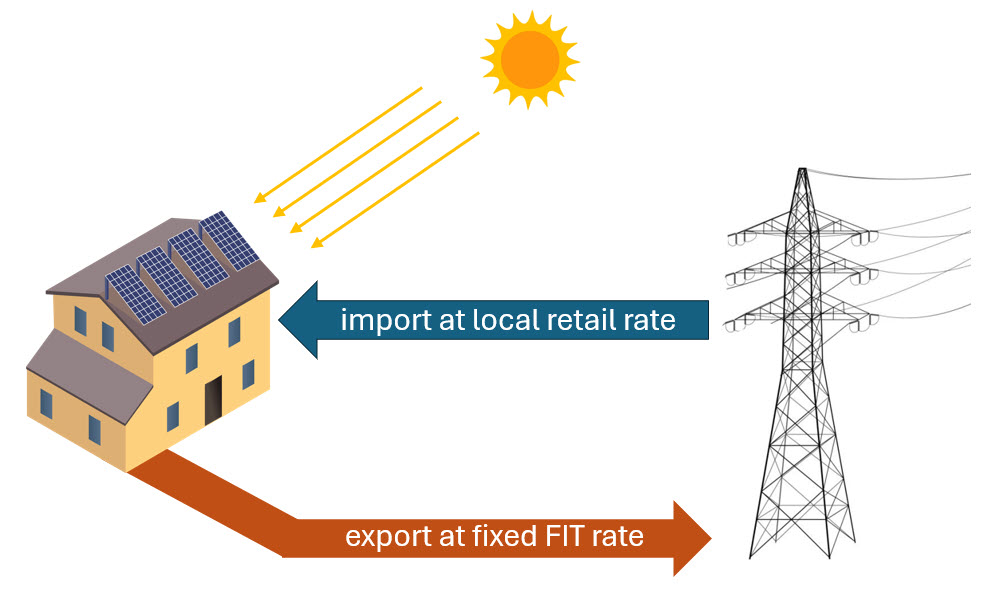
Any renewable energy producers – business owners, home owners, farmers – are eligible for FIT in the states and countries that have that policy in place. As of 2024, three states – California, Indiana, and New York - have feed-in tariffs (Investopedia [20], 2024), and they are also broadly used in other countries, such as Germany, China, and Japan.
FIT may appear very attractive to small- to medium-scale solar producers since it offers a steady income for a considerable period of time, thus securing payoff of the installed SECS. However, larger commercial producers often choose a more market-driven pathways, such as power purchase agreements (PPA), which offer more space for negotiation and possibly higher revenues under favorable market conditions.
Here are some pros and cons of this policy approach:
|
Pros |
Cons |
|
Guaranteed Payments: Provides a fixed payment for energy produced, offering predictable revenue. |
Fixed Rates: The rates are set and may be lower than market rates, potentially limiting profitability. |
|
Reduced Risk: Mitigates financial risk by ensuring a stable income, regardless of market fluctuations. |
Long-Term Commitment: Requires a commitment to sell energy at fixed rates for a long period, which may not be ideal in rapidly changing markets. |
|
Support for Small Producers: Benefits individuals and small-scale producers who might not otherwise be able to invest in renewable energy. |
Administrative Burden: Involves navigating regulatory requirements, which can be cumbersome for larger entities. |
|
Encourages Investment: Stimulates investment in renewable energy by providing financial certainty. |
Market Disruption: Can potentially disrupt market dynamics by setting prices that may not reflect current supply and demand conditions. |
Time-of-use plans
The idea of “time-of use” generation is that the rates at which you sell electricity back to the grid are not fixed but depend on the time of day. For example, rates are highest from 4 to 9 p.m., when residents come home from work and use electricity. Overnight from 12 a.m. to 6 a.m., energy use is lower because people are sleeping, so rates are also lower. So you would be compelled to sell your electricity during the peak hours since in that case you will get more credits. And that helps the utility address the peak demand more effectively.
Time-of-use energy plans help you save more if you are strategic with electricity use. You can use daytime cheaper electricity (generated by PV) for charging your electric vehicle or a battery. Then during the peak hours, you can use the stored electricity and supply the rest of it to the grid at a higher rate.
Importance of batteries
The time-of-use plans encourage the addition of a solar battery. Stored solar energy can be used during peak hours when the rates are extra high to reduce energy costs by not relying on the grid for electricity. New policies in California (NEM 3.0) especially capitalize on this approach.
Solar Permitting
Permitting is the unseen monster of project development that will slow or stop a project from moving forward. The key rewards of an established permitting process for SECS include reduced costs of installation and faster turnaround from design to deployment. It will be well worth your integrative design team's time to familiarize yourselves with the permitting process for your locale of interest.
Best practices have been itemized by IREC in this material:
Policy and permitting is an evolving pattern in the renewable energy world. As solar energy rolls out to new municipalities, and adoption rates increase, the pressure to establish an efficient permitting process arises. I would like you to review these documents for this part of the lesson:
- IREC/Vote Solar (2013) "Solar Permitting Best Practices [4]." (Accessed from IREC [21])
We can distill those into a few core features that we would hope for in an integrative process that includes permitting:
- speed of processing (expedited processing, online processing);
- transparency of the process (requirements posted online and openly);
- reduced permitting costs (flat fee over value-based fees); and
- supporting permitting staff are knowledgeable of solar installations.
Self-Check
9.4 National Targets for Renewable Energy Portfolios
Reading Assignment
- REN21's Renewables Global Status Report (GSR) [5] (no, not the whole thing) (updated 2019):
- Please read the Chapter 3 Markets and Industry Trends, the section on Solar Photovoltaics (PV). If you have extra time, scan the review on CSP and Solar Thermal Heating and Cooling),
- review all Solar PV Figures addressing Global and Country Capacities and Capacity Additions.
- What are national and international targets for renewable energy integration, and where does solar fit in the portfolio? Up until now, we have really isolated our focus to the USA, but each country has a role to play in ramping up renewables in response to needed climate actions.
Different Countries, Different Approaches
So, first, "REN21" is the acronym for the "Renewable Energy Policy Network for the 21st Century". REN21 is a non-profit network of stakeholders established to connect key contributors from governments, international organizations, industry partners/associations, participants from science and academia, and society at large. We are using their centralized information base to expose the diverse approaches that countries can take to develop energy generation and manage energy demand at the Federal level.
After reviewing the REN21's Renewables GSR, you will have a little broader perspective on the various approaches, and will be able to compare solar policies in Germany vs. China vs. Columbia vs. Kenya.
9.5 Discussion Activity
Yellowdig Discussion - National PV Targets for Electricity Production
For this lesson discussion, do some online research on national targets for PV solar power. You can use the REN21 Renewables Global Satus Report [5] as a starting point, but certainly feel free to search other available resources. Take a look at different several key players representing different continents that are actively setting PV targets:
- Argentina
- India
- South Africa
- Australia
After reading and taking down some comparative notes, use these guiding questions to create your post in Yellowdig:
- What do these countries have in common with the choice of targets?
- How do their time horizons compare?
- Has there been a notable progress in these countries to achive these target?
- Can you speculate as to why these countries have large targets for PV, while other countries (e.g. Russia) do not?
- Whar are geographic, economic, and other prerequisites for setting renewable energy targets in these regions?
Tagging
Please feel free to use the following topics for your discussion posts this week:

Grading and Deadlines
Remember that Yellowdig point earning period ends each Friday. Posting commenting, reacting regularly through the weeek will make the 1000 pts. an easy target and guarantee a high participation grade in the course. Yellowdig discussions will account for 15% of your total grade.
9.6 The Sun as a Resource System and Common Pool Resource
Reading Assignment
- J.R. Brownson, Solar Energy Conversion Systems (SECS), Chapter 11 - The Sun as Commons (Read the Intro through "Framework: Emerging Local Policy Strategies.")
- J.R.S. Brownson (2013). "Framing the Sun and Buildings as Commons [6]." Buildings 3(4), pp. 659-673; doi:10.3390/buildings3040659.
I want you to consider the perspective where we view the resource units derived from the sun (light, converted electrons, converted heat, etc.) and the resource systems to enable those conversions (the Sun, the grid, our buildings) as coupled, but separate entities. This is an extension of our work on economics, but leads us into thinking about management of solar energy among the community.
While reading these materials, think how we might collectively manage both the resource units, and the resource systems in a given locale. Community solar is a new and exciting space in the solar field, and this sets up the foundation to address it and think of new strategies in management.
Language of the Commons
In both readings, we are going to see the language developed by Nobel Laureate in Economics Elinor Ostrom, from her seminal book, Governing the Commons: The Evolution of Institutions for Collective Action.
- Resource Systems: the larger stock from which a good is appropriated.
- Resource Units: the flow of goods being produced.
- Providers: teams or individuals who arrange for the provision of a resource system at multiple levels, to ensure long-term stability or sustainability of the resource system.
- Producers: teams and individuals who construct, commission, and maintain access to the resource system.
- Appropriators: individuals who make use of resource units.
- Arbiter: a third party, as either an impartial person or an institution, that is given the power to decide among stakeholders in a controversy.
From this, we state that the Sun is an energetic resource system providing the flow of light (as resource units) in the shortwave band (280–2500 nm). Once we have established our language for resource systems and resource units, we can review the Typology of Goods, discussed with examples in the article by Brownson (2013). We summarize those four main goods below:
- Excludable Goods: restriction of access to the good. High excludability means access to the good can be intentionally restricted, while low excludability means one cannot easily restrict access to the good.
- Rivalrous Goods: when the appropriation of a good takes away from another’s ability to appropriate that good (called subtractable). High rivalry means that the goods are subtractable (independent of excludability), while low rivalry means that subtraction of a unit of the good does not take away from the ability of another to use the good.
- Private Good: when a good is both rivalrous and excludable.
- Public Good: when a good is both non-rivalrous and non-excludable (really big resource systems like the Sun).
- Club Good: when a good is non-rivalrous and excludable.
- Common Good: when a good is rivalrous but non-excludable.
Self-Check
9.7 Community Solar
Reading Assignment
NREL Report: J. Coughlin, J. Grove, L. Irvine, J. F. Jacobs, S. Johnson Phillips, A. Sawyer, and J. Wiedman (2012). "A Guide to Community Shared Solar: Utility, Private, and Nonprofit Project Development [7]." USA DoE National Renewable Energy Laboratory.
- Read Sections 1 and 2 (pp. 2-32)
- Scan through Section 3: "Emerging State Policies to Support Community Shared Solar" and Section 7: "Resources"
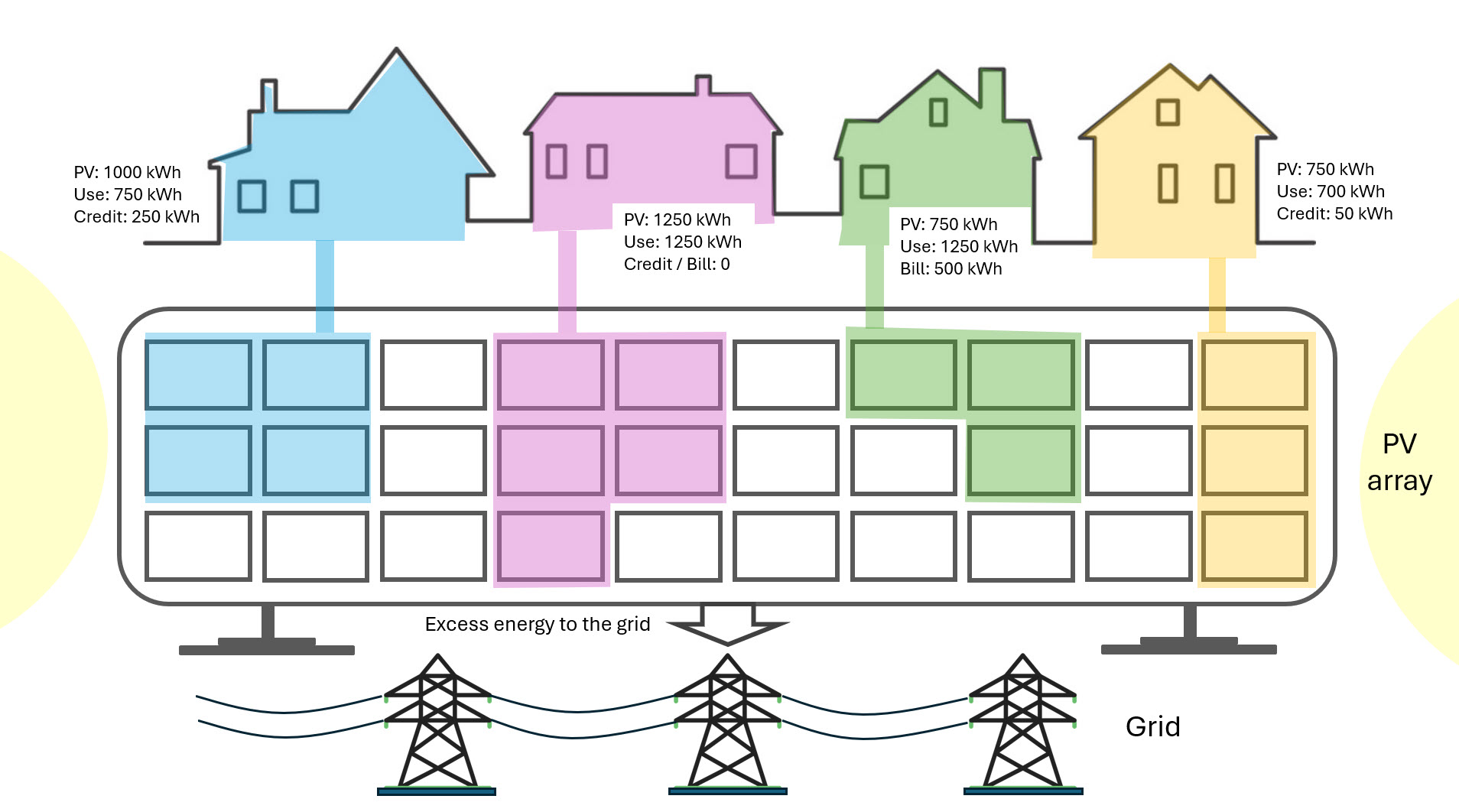
Models of Community Solar
Our final reading puts a few boundaries around the varieties of "community solar" that appear to be emerging in the USA of late. There are good examples in the document, which will be helpful for our Learning Activity in this lesson.
- Utility-Sponsored Model: A utility owns or operates a project that is open to voluntary ratepayer participation.
- Special Purpose Entity (SPE) Model: Individuals join in a business enterprise to develop a community shared solar project.
- Nonprofit Model: A charitable nonprofit corporation administers a community shared solar project on behalf of donors or members.
Optional Reading
This web article [22]does a good job explaining the principle and various models of community solar:
"An individual now has the opportunity to reap the benefits of solar without having to be a wealthy homeowner in California. Depending on where you live in the country, you can now share an array with your neighbors; lease an array from a third-party; join a solar co-op – the choice can now be yours. Through a community solar project, participants benefit from one shared system usually located on a piece of land that is not necessarily owned by any of the users. The electricity generated generally costs less than the price participants would ordinarily pay to their utility. Community solar allows people to go solar even if they do not own property. There are a number of different ways that shared renewable energy can operate, each falling under one of two categories: ownership or subscription." [Etelson, 2024]
While community solar PV is just now emerging onto the market, note that community solar products have been in existence for millennia as shared fields and gardens for produce development and resale. Based on the prior examples from farming, the management of a community resource is well within the scope of SECS expansion.
Community Solar Case Studies
As of 2023, Community Solar is now authorized in 24 states, Puerto Rico and Washington, D.C. (see map below). There are companies that specialize in community solar that would arrange deals with farmers to lease portions of their land to build solar projects. As this segment of the solar industry expands, farmers (and landowners in general) may take advantage of this new revenue stream. In addition to generating local revenue, solar projects help states make progress toward their clean energy and sustainability goals [Gahl, 2020].
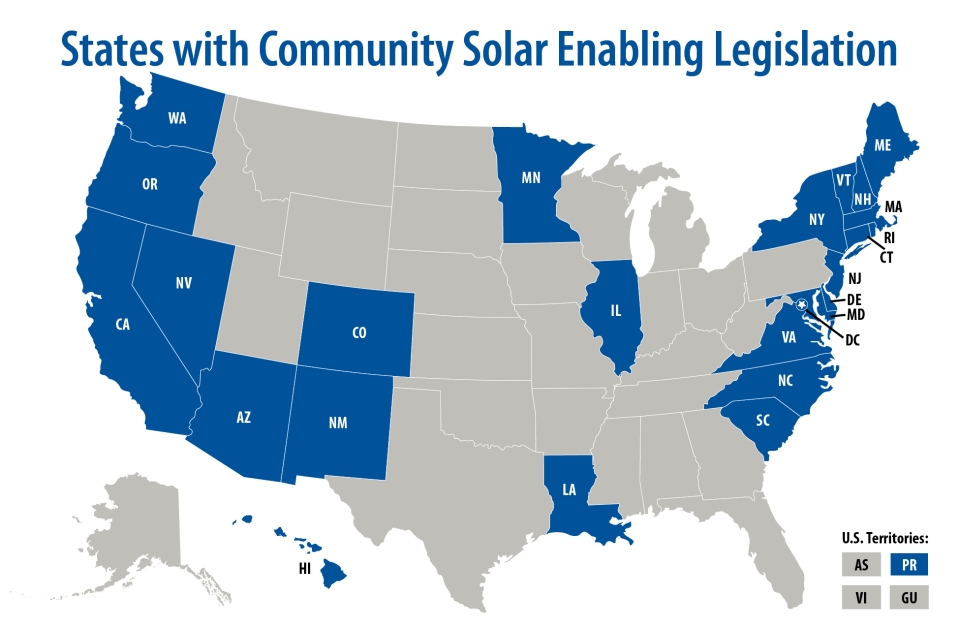
Browse through this report to learn about several representative community solar case studies across the country:
SEIA Report: Gahl, D., How Community Solar Supports American Farmers [24], SEIA, February 2020.
The case studies presented in the report show that typically, farms will lease portions of their land to community solar companies for a fixed term at a fixed price. These solar lease payments tend to be higher than those for traditional agricultural operations and are normally based on the state policies, where the project is located. Land leasing for solar often provides farmers with higher and more stable income than that obtained through producing agricultural products, which creates an incentive.
9.8 Learning Activity: Community Solar Garden
Scenario
Imagine you are part of a superior design team based in PA, a state with a restructured electricity market such that community solar is possible. Your integrative design team is already capable at commercial and residential PV installations, but wants to branch out and take advantage of this "community solar" concept. Your job is to make a short survey of best practices available elsewhere and suggest a model for developing community PV in an urban community in the Philadelphia area. Understandably, your report would be based on limited information of the actual site, but you can leverage extensive access to general information about the types of building and potential stakeholders in the locale of interest. Based on your findings, you need to prepare a concise but convincing summary document for your supervisor to review.
Directions
- Find and review a case of community shared solar anywhere that would align with a prospective community solar scenario in Philadelphia area. Make sure to state the commonalities in that real case with those in the potential project scenario.
- Develop a 2-3 page executive summary that includes:
- background information of the locale,
- client base and stakeholders,
- proposed model for community solar,
- comparative analysis (cons and pros) for community solar vs. individual solar. (If you like, you can present this information in a table).
- Provide a conclusive statement about the feasibility and benefits of the project.
Submission
Submit your Summary as a PDF document into the Lesson 9 Learning Activity Dropbox: Community Solar in Canvas. Remember to appropriately cite any sources of information used in your report.
Grading Criteria
You will be graded on your ability to develop a compelling outline that provides scope for applying the community solar concept in a residential Philadelphia neighborhood. The activity assesses your knowledge of investigating the potential client and stakeholders at the locale when planning to maximize solar utility in the pre-design phase. Please see specific grading rubrics in Canvas.
Deadline
Please see the Canvas Calendar for specific due dates.
9.9 Summary and Final Tasks
You have reached the end of Lesson 9!
Summary
In this lesson, we attempted to flesh out some major policy topics tied to solar energy. In doing so, we were able to describe the connections between policy-making and renewable energy adoption at the local, regional, and federal levels. We explored the deeper meanings and implications of solar rights and solar access, which engage multiple stakeholders from a local and regional government. Then, we addressed the policy and permitting barriers/opportunities in solar project development.
Recall that we want to help our client to manage risk in the social environment, through our skill in negotiating permitting and policy barriers within the given locale. A good solar resource and a sound financial return (in principle) alone doesn't guarantee the locale will even allow a SECS, or to implement a system in a financially responsible manner.
The research of Dr. Ostrom suggested to us how local community action for solar energy is not only possible but is actively used today in other similar industries, where the dynamic appropriation and provisioning challenges of a resource system and resource units are addressed in a sustainable fashion. In turn, we used that thought process to describe new and expanding methods for community solar development.
Reminder - Complete all of the Lesson 9 tasks!
You have reached the end of Lesson 9! Double-check the to-do list on the Lesson 9 Learning Outcomes page to make sure you have completed all of the activities listed there before you begin Lesson 10.